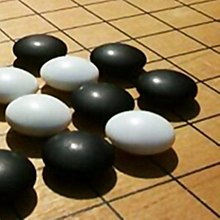List of Go games

| Part of a series on |
| Go |
|---|
 |
| Game specifics |
|
| History and culture |
| Players and organizations |
| Computers and mathematics |
Throughout history, a number of notable Go games have taken place.
Blood-vomiting game
[edit]The blood-vomiting game (Japanese: 吐血の一局) was played during the Edo period of Japan, on June 27, 1835, between Honinbo Jowa (white) and Intetsu Akaboshi (black). It is noted for three brilliant moves played by Jowa, and for the premature death of the Go prodigy Intetsu Akaboshi, who died after coughing up blood onto the board after the game.
Ear-reddening game
[edit]
The ear-reddening game (Japanese: 耳赤の一局) was played during the Edo period of Japan, in 1846 between Honinbo Shusaku (black) and Inoue Gennan Inseki (white). The game contains the "ear reddening move" (move 127), so named when a doctor who had been watching the game took note of Gennan as his ears flushed red when Shusaku played the move, indicating he had become upset.
The Game of the Century
[edit]

The game of the century refers to a famous game of go between Honinbo Shusai (white) and Go Seigen (black) that was played to celebrate the 60th birthday of Honinbo Shusai. The game began on October 16, 1933, and finished on January 29, 1934. Each player was given twenty-four hours of thinking time. Shusai was the doyen of the Go world, as he was the head of the famous Honinbo Go school, the most prestigious of the schools founded at the behest of Shōgun Tokugawa Ieyasu at the start of the 17th century. Go Seigen was famed as a prodigy, first among a generation of young new brilliant players, and would go on to become one of the most celebrated players of the 20th century. This led newspapers to dub the match the game of the century.
The tradition at the time dictated whoever played White had the right to adjourn the game at any time, and there was no sealing of moves. This meant that Shusai, being the nominally stronger player and thus holding White, could adjourn the game whenever it was his turn to play and continue deliberating at his leisure during the adjournment. Shusai called adjournments some 13 times, all at the start of his turn to move, thus prolonging the match to a period of three months (16 October 1933 – 19 January 1934). For instance, on the eighth day of the match, Shusai played first and Go Seigen replied within two minutes. Shusai then thought for three and a half hours but only to adjourn the game. During these adjournments, Shusai would retreat home to study the game with his students.
At the start of the game, Go Seigen played what at the time was considered a shocking series of moves at the three-three, star and center points.[1] Such unusual and innovative moves were considered by Shusai's supporters to be an insult to the Honinbo.[citation needed]
Shusai trailed throughout the game until, on the 13th day of the match, he made a brilliant move at W160, now celebrated, leading to his victory with a 2 point difference. It was rumored that it was not Shusai but one of his students, Maeda Nobuaki, who was the author of this ingenious move. Segoe Kensaku told a reporter this, in what he thought was an off-the-record interview.[2] Maeda himself even hinted as much. When presented with the opportunities to debunk these rumors, Maeda neither denied nor confirmed them.[3]
Atomic bomb game
[edit]The atomic bomb Go game is a celebrated game of Go that was in progress when the atomic bomb was dropped on Hiroshima, Japan, on August 6, 1945. The venue of the game was in the suburbs of Hiroshima, about 5 kilometers (3.1 mi) from ground zero.[4]
The game was about to enter its third and final day of play when the bomb dropped at 8:15 am. The players—Utaro Hashimoto, who was the Honinbo title holder, and Kaoru Iwamoto, who was the challenger—had replayed the game to the adjourned position but had not yet started to play on. The explosion caused disruption to the game, damage to the building, and some injuries to those attending the match. Play was resumed after the lunch break, and the game was played to a conclusion that evening. Hashimoto, holding White, won by five points.
Game 1 of the match had been played from July 23 to 25 in the centre of Hiroshima. The move to further out of the city area was recommended by the police, after a drop of propaganda leaflets.[5]
The match was continued after the war, ending in a 3–3 draw. A three-game playoff was held in 1946, won by Iwamoto in two straight games to claim the Honinbo title (becoming Honinbo Kunwa). Utaro went on to reclaim the title in 1950.[6]
Atomic Bomb Go Game at play 106, when the bomb exploded on Hiroshima.[7]
Lee's broken ladder game
[edit]This was a match between Lee Se-dol and Hong Chang-sik during the 2003 KAT cup. This game is notable for Lee's use of a broken ladder formation.
Normally playing out a broken ladder is a bad mistake, a pitfall associated with bad beginner play; the chasing stones are left appallingly weak. Between experts it should be decisive, leading to a lost game. Lee, playing black, defied the conventional wisdom, pushing development of the ladder to capture a large group of Hong's stones in the lower-right side of the board. Although Black could not capture the stones in the ladder, White ultimately resigned.[8]
| | |||||||||||||||||||||||||||||||||||||||||||||||||||||||||||||||||||||||||||||||||||||||||||||||||||||||||||||||||||||||||||||||||||||||||||||||||||||||||||||||||||||||||||||||||||||||||||||||||||||||||||||||||||||||||||||||||||||||||||||||||||||||||||||||||||||||||||||||||||||||||||||||||||||||||||||||||||||||||||||||||||||||||||||||||||||||||||||||||||||||||
| Moves 67 to 74 (Black: Lee Se-dol; White: Hong Chang-sik) |
| |